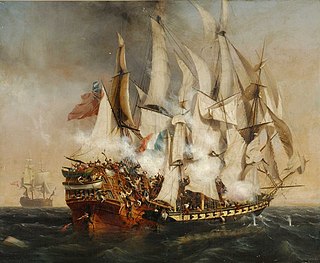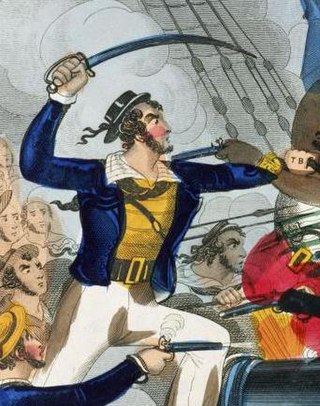
A cutlass is a short, broad sabre or slashing sword, with a straight or slightly curved blade sharpened on the cutting edge, and a hilt often featuring a solid cupped or basket-shaped guard. It was a common naval weapon during the early Age of Sail.

USS Higgins (DDG-76) is a United States Navy Arleigh Burke-class destroyer. Higgins is the 26th ship of her class, and the 15th of the class to be built by Bath Iron Works of Bath, Maine. Construction began on 14 November 1996 and she was launched and christened on 4 October 1997. She was commissioned at a ceremony in Port Everglades, Florida on 24 April 1999. She is part of Destroyer Squadron 15 within the Seventh Fleet, and is homeported at United States Fleet Activities Yokosuka in Yokosuka, Japan.

USS Preble (DDG-88) is an Arleigh Burke-class destroyer in the United States Navy. She is the sixth U.S. Navy ship named in honor of Commodore Edward Preble, who served in the American Revolutionary War and was one of the early leaders of the Navy.

The surface warfare insignia is a military badge of the United States Navy which is issued to U.S. Navy personnel who are trained and qualified to perform duties aboard United States surface warships. There are presently four classes of the surface warfare pin, being that of line, staff, special operations, and enlisted. The line and enlisted surface warfare badges may be earned by United States Coast Guard personnel assigned to Navy commands. The various badge types are as follows:

The Altmark incident was a naval incident of World War II between British destroyers and the German tanker Altmark, which happened on 16–17 February 1940. It took place in what were, at that time, neutral Norwegian waters. On board the Altmark were roughly 300 Allied prisoners, whose ships had been sunk by the pocket battleship Graf Spee in the Southern Atlantic Ocean.

A pistol sword is a sword with a pistol or revolver attached, usually alongside the blade. It differs from a rifle with a bayonet in that the weapon is designed primarily for use as a sword, and the firearm component is typically considered a secondary weapon designed to be an addition to the blade, rather than the sword being a secondary addition to the pistol. In addition, the two components of these weapons typically cannot be separated, unlike most bayonet-fixed rifles.

The Iraqi Naval Forces, or the Iraqi Navy is the naval warfare service branch of the Armed forces of Iraq. Formed in 1937, initially as the Iraqi Coastal Defense Force, its primary responsibilities was the protection of Iraq's coastline and offshore assets, the official name was changed on 12 January 2005 to Iraqi Naval Forces

The capture of USS Chesapeake, also known as the Battle of Boston Harbor, was fought on 1 June 1813, between the Royal Navy frigate HMS Shannon and the United States Navy frigate USS Chesapeake, as part of the War of 1812 between the United States and the United Kingdom. The Chesapeake was captured in a brief but intense action in which 71 men were killed. This was the only frigate action of the war in which there was no preponderance of force on either side.

In admiralty law prizes are equipment, vehicles, vessels, and cargo captured during armed conflict. The most common use of prize in this sense is the capture of an enemy ship and her cargo as a prize of war. In the past, the capturing force would commonly be allotted a share of the worth of the captured prize. Nations often granted letters of marque that would entitle private parties to capture enemy property, usually ships. Once the ship was secured on friendly territory, she would be made the subject of a prize case: an in rem proceeding in which the court determined the status of the condemned property and the manner in which the property was to be disposed of.

Law Enforcement Detachments or LEDETs are specialized, deployable maritime law enforcement teams of the United States Coast Guard. First established in 1982, their primary mission is to deploy aboard U.S. and allied naval vessels to conduct and support maritime law enforcement, interdiction, or security operations. LEDETs are the operational elements of the Coast Guard’s two Tactical Law Enforcement Teams (TACLETs) which were part of the Coast Guard’s Deployable Operations Group (DOG) from 2007 to 2013. As of April 2010 there are seventeen LEDETs.
A combination weapon is a close-quarters gun hybrid combining the features of both a firearm and an edged melee weapon. Examples of gun hybrids include knife/pistols and pistol/sword combinations.

Combined Task Force 150 (CTF-150) is a multinational coalition naval task force working under the 34-nation coalition of Combined Maritime Forces and is based in Bahrain established to monitor, board, inspect, and stop suspect shipping to pursue the "Global War on Terrorism" and in the Horn of Africa region (HOA) includes operations in the North Arabia Sea to support operations in the Indian Ocean. These activities are referred to as Maritime Security Operations (MSO).

Visit, board, search, and seizure (VBSS) is the term used by United States military and law enforcement agencies for maritime boarding actions and tactics. VBSS teams are designed to capture enemy vessels, combat terrorism, piracy, and smuggling, and to conduct customs, safety and other inspections.

Naval boarding action is an offensive tactic used in naval warfare to come up against an enemy marine vessel and attack by inserting combatants aboard that vessel. The goal of boarding is to invade and overrun the enemy personnel on board in order to capture, sabotage or destroy the enemy vessel. While boarding attacks were originally carried out by ordinary sailors who are proficient in hand-to-hand combat, larger warships often deploy specially trained and equipped regular troops such as marines and special forces as boarders. Boarding and close quarters combat had been a primary means to conclude a naval battle since antiquity, until the early modern period when heavy naval guns gained tactical primacy at sea.

The Post Office Packet Service dates to Tudor times and ran until 1823, when the Admiralty assumed control of the service. Originally, the Post Office used packet ships to carry mail packets to and from British embassies, colonies and outposts. The vessels generally also carried bullion, private goods and passengers. The ships were usually lightly armed and relied on speed for their security. However, Britain was at war almost continuously during the 18th and early 19th centuries with the result that packet ships did get involved in naval engagements with enemy warships and privateers, and were occasionally captured.

Kent, launched in 1799, was an East Indiaman of the British East India Company. On her first voyage in 1800 she was on her way to Bengal and Bencoolen when the French privateer Robert Surcouf captured her near the mouth of the Ganges.

USRCSurveyor was a ship of the United States Revenue Marine captured by the United Kingdom during the War of 1812. Despite the vessel's loss, the "gallant and desperate" defense of her crew against a superior force of the Royal Navy and the Corps of Royal Marines is commemorated by the United States Coast Guard. Along with the Royal Navy frigate which bested her in battle, HMS Narcissus, Surveyor is among six legendary ships memorialized in the lyrics of the Coast Guard march "Semper Paratus".

A boarding net is a type of rope net used by ships during the Age of Sail to prevent boarding by hostile forces. Designed to hang from a ship's masts and encircle its deck, the boarding net could be deployed during battle or at night when a ship was at anchor in unknown or hostile waters. In the Royal Navy, boarding nets first gained widespread use in the 1790s.

Ratings of the Royal Navy have used cutlasses, short, wide bladed swords, since the early 18th century. These were originally of non-uniform design but the 1804 Pattern, the first Navy-issue standard cutlass, was introduced at the start of the 19th century. This was a bluntish weapon that was perhaps intended for cutting away canvas and ropes rather than as a thrusting combat weapon. The 1845 Pattern cutlass introduced a bowl-style hand guard which provided greater protection, with a longer and more curved blade. Its sharper point made it more useful for thrusting attacks, which were now emphasised in the drill manual. The 1845 Pattern was modified several times including shortening and straightening the blades, which weakened them. The 1889 Pattern had a straight, spear-pointed blade with a hilt that curved outwards to catch and redirect an opponent's sword point. The 1900 Pattern, the last navy-issue cutlass, was similar to its predecessor with the introduction of a fuller and a hilt insert that cushioned the user's little finger. The cutlass was withdrawn from service in 1936 but remains in use for ceremonial purposes. It is thought that it was last used in combat in 1900 during the Boxer Rebellion.
















